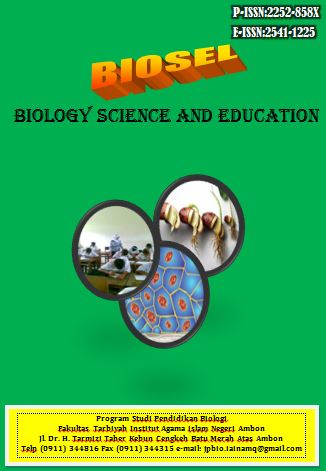Effect of Crab Shell Chitosan POC (Portunus pelagicus) on the Growth of Horse Tooth Corn (Zea mays sindetat)
DOI:
https://doi.org/10.33477/bs.v14i1.7809Abstract
Crab shell waste can be used as raw material for making chitosan. Chitosan is the result of chitin degassing which has many benefits, including in agriculture. Chitosan has been proven to increase plant growth. In the agricultural industry, chitosan can be used as POC. This study aims to determine the effect of POC chitosan from crab shells (P. Pelagicus) on the growth of horsetooth corn (Z. mays syndetat). The type of quantitative research with a field experiment approach using 1% chitosan POC treatment from male, female and mixed male and female crab shells, as much as 20 ml of 1% chitosan/1 liter of water. The indicators observed were plant height, stem diameter and number of leaves. Using RAK (completely randomized design) with Anova analysis (one way) assisted by SPSS version 20. The results showed that POC chitosan from male, female and mixed crab shells had an effect (sig <0.05) on plant height, stem diameter and number of leaves. The best effect was shown by mixed chitosan POC on plant height (89.00 cm), male chitosan POC on stem diameter (15.61 mm) and male, female, mixed chitosan POC on the number of leaves (10.00 strands).
Keywords: Chitosan POC, Crab Shell Waste, Horse Tooth Corn
Downloads
Published
Issue
Section
License

This work is licensed under a Creative Commons Attribution-NonCommercial 4.0 International License.
Authors who publish with this journal agree to the following terms: Authors retain copyright and grant the journal right of first publication with the work simultaneously licensed under a Creative Commons Attribution License that allows others to share the work with an acknowledgement of the work's authorship and initial publication in this journal. Authors are able to enter into separate, additional contractual arrangements for the non-exclusive distribution of the journal's published version of the work (e.g., post it to an institutional repository or publish it in a book), with an acknowledgement of its initial publication in this journal. Authors are permitted and encouraged to post their work online (e.g., in institutional repositories or on their website) prior to and during the submission process, as it can lead to productive exchanges, as well as earlier and greater citation of published work.













